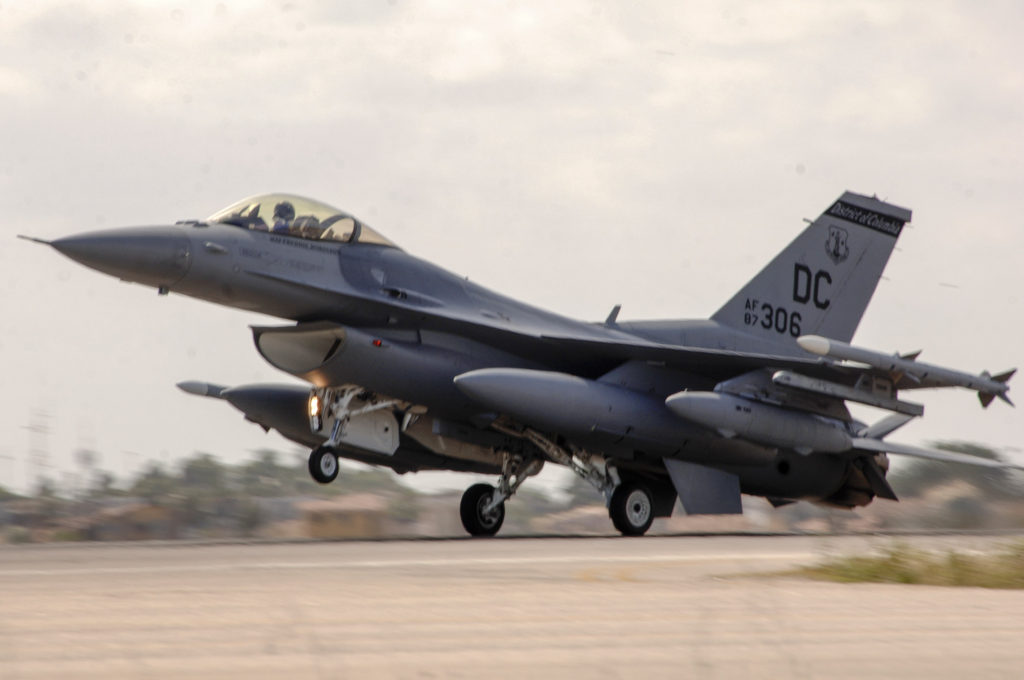The U.S. Air Force Accident Investigation Board found that improper assembly of the main engine control caused the April 5 F-16C crash in Maryland, Air Combat Command said in a Thursday press release.
The aircraft, valued at $22,198,075, was destroyed on impact. It was assigned to the 113th Wing, 121st Fighter Squadron, Joint Base Andrews, Maryland.
The Accident Investigation Board report said the environmental clean-up cost was $856,777.
The incident
Shortly after taking off on a routine surface attack training mission from Joint Base Andrews along with three other aircraft, the plane, powered by a General Electric F110-100C engine, “experienced an uncommanded engine acceleration, followed by a loss of thrust,” the report said. This led to an engine fire.
The pilot jettisoned the external wing fuel tanks to decrease weight and increase glide distance, and extinguished the fire, but the aircraft had suffered catastrophic engine failure. The nearest airfield was beyond the F16’s glide capabilities and the pilot directed it toward a nearby open field prior to ejecting. The aircraft crashed in a wooded area and the pilot was unhurt.
The report findings
Accident Investigation Board President Colonel David V. Cochran found by “preponderance of evidence that the cause of this mishap was the incorrect assembly of the main engine control (MEC) differential pressure pilot valve, which was missing a required 600-degree retaining ring and the anti-rotation pin,” the report said.
The missing parts caused the main engine control to malfunction and “incorrectly meter abnormally high fuel flow to the engine.” This led to “severe engine overspeed, severe engine over-temperature, and engine fire, which resulted in a catastrophic engine failure.”
The investigator found that a substantially contributing factor was the “lack of an adequate procedural requirement for MEC parts accountability in the 552d Commodities Maintenance Squadron, MEC Overhaul Shop.”
F-16 engine overhaul
Prior to the incident, the F-16C block 30H aircraft, tail number 87-0306, which was delivered to the Air Force in December 1988, had accumulated 6,183 flight hours, and had flown 30 hours since May 10, 2016.
The engine was installed on June 20 of the same year. It went through a modernized digital engine control upgrade on March 31, 2017, and had accumulated 0.0 flight hours prior to the incident.
The 552d Commodities Maintenance Squadron, MEC Overhaul Shop at Oklahoma City – Air Logistics Complex, was responsible for the overhaul of of the engine. The MEC overhaul process consists of complete disassembly, inspection, appropriate parts replacement, reassembly and on-site testing.
After the overhaul of the MEC in the incident, it underwent testing on January 31, and “failed to meet performance standards.”
After this failure it was inspected. An error was found and corrected and it was retested on February 16. It again failed to meet performance standards and was rechecked and repaired and tested for a third time on March 8, and was deemed serviceable.
This test “was conducted utilizing a static test stand with no induced vibration,” which does not simulate “the actual stresses or loads associated with an operational flight,” the report said.
“Ultimately, the MA MEC passed final testing as intended, despite having missing parts.”
The report found that “there is no process to determine if all required parts have been installed after overhaul and assembly completion.” It said “some parts remained in part trays from previous assembly kits, with no way to determine if all required parts were installed.”
However, the report found that due to the small size of the missing parts and the complexity of the task, “misassembly of the differential pressure pilot valve could still have occurred, even if an adequate parts accountability program was in place.”
Air Force spokesperson Jerry Bryza told CNN that a full end-to-end process audit of the F-16 main engine control production line was undertaken following the crash.
“Process improvement measures were taken and additional quality checks throughout the assembly and test portions of the overhaul process were added to include two-step visual verification that 100% of required replacement items had been installed during overhaul,” he said.
The overhauled MEC was received by 113th Maintenance Squadron on April 3. It was installed on April 4, and passed an operational engine run test, and the aircraft was returned to service. The report said there is no evidence to suggest 113th Maintenance Squadron were a factor in the incident.



